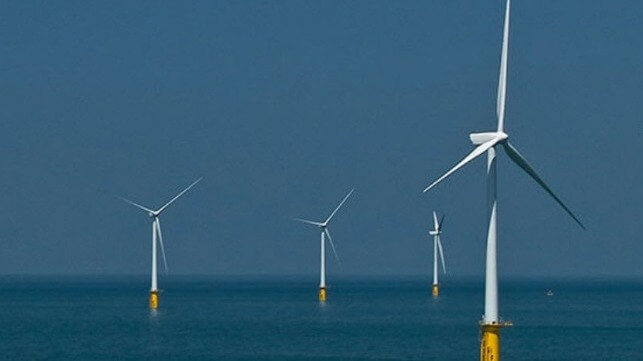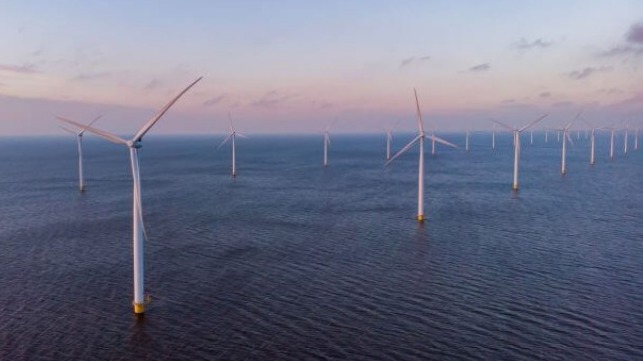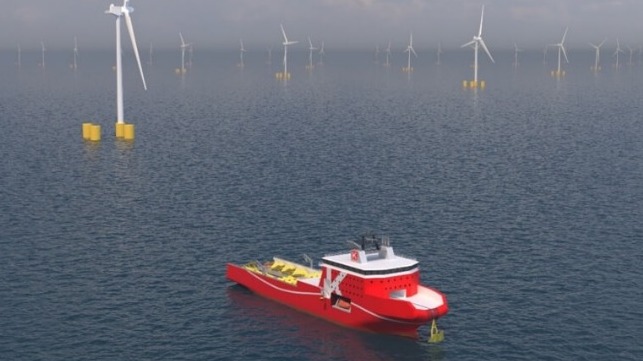Germany Accelerates Offshore Wind Development With Three Sites for 5.5GW

Germany’s Federal Maritime and Hydrographic Agency (BSH) has issued the fourth phase of its offshore wind program publishing the results of surveys for three new lease areas in the North Sea. They are releasing the details and beginning the second auction of 2024 with a deadline established of August 1 for bids on the three new sites.
The authority published the 4th WindSeeV, which contains the results of the preliminary area investigation for the construction of the three offshore wind farms. The newest area is in the western reaches of Germany’s North Sea exclusive economic zone near the border with the Netherlands.
BSH President Helge Heegewaldt commented, “With the entry into force of the 4th WindSeeV, the BSH is giving the offshore industry planning and legal certainty for the construction of three wind farms with an installed capacity of 5,500 MW in the North Sea. We are thus reaching another major milestone on the way to the Federal Republic of Germany’s 70 GW target.”
One of the three areas covers 158 km2 (61 square miles) with an installed capacity of 2,000 MW. It is located approximately 98 km off the Dutch island of Ameland and 107 km off the German island of Borkum. A similar-sized second area is located approximately 101 km from the nearest island, Ameland (Netherlands), and 111 km from the German island of Borkum. The third area is slightly smaller at 106 km2 (40 square miles) and would have a capacity of 1,500 MW. The shortest distance to the nearest island Rottumerplaat (Netherlands) about 108 km and it is a similar distance from Borkum as the other two parcels.
In addition to the three new sites, for which developers will have the benefit of the pre-investigation reports, last month the German authority also launched an auction for sites that could provide 2.5 GW of capacity in the North Sea. These sites, however, have not been pre-investigated. This follows similar auctions in 2023 for 7 GW of capacity.
Germany’s Federal Ministry of Economics is also moving forward with a draft law for the implementation of the third Renewable Energy Directory. To speed the development of offshore wind assets, the draft proposes replacing the requirement for project-specific environmental impact assessments (EIA) with a broader strategic assessment for the areas yet to be designated.
In a rare move, some of the leading wind farm developers including Ørsted, RWE, and Vattenfall, joined with environmental groups calling for continuing the EIA requirement. They said this step creates better legal certainty for the developer and aids in investment decisions. They argue that the EIA does not delay the overall development of the projects.
The German government is looking to streamline the process to encourage more development and address challenges in the supply chain to ensure more projects are entering the pipeline. Experts however argue that one of the biggest challenges in the German industry is delays in developing the offshore grid connection systems in the North Sea.
New York Re-Ups Two in Jeopardy Wind Farms in Fourth Solicitation

New York State announced the results of its fourth, expedited offshore wind solicitation, which was used as a vehicle to stabilize two in-jeopardy wind farm projects and reinvigorate the state’s efforts after the financial headwinds threatened the industry in 2023. The state conditionally awarded Empire Wind 1 and Sunrise Wind agreements clearing the way for the projects to negotiate new power agreements. A third project, Community Offshore Wind II, was also “waitlisted” with consideration for later contract negotiations.
New York Governor Kathy Hochul highlights that these are two mature projects that have already cleared most of the permitting milestones and can move forward quickly. The projects total over 1.7 GW of electricity, which the Governor said will be the largest power generation projects in New York State in over 35 years once they are in operation in 2026.
Inflation, rising costs, supply chain problems, and challenges due to the lack of installation vessels, combined to place the projects in danger. Empire Wind, which was to be developed in a partnership between Ørsted and Eversource, and Sunrise Wind, which was to be developed by the Equinor and BP partnership, both petitioned NYSERDA (New York State Energy Research and Development Authority) to reset their 2019 offtake contracts. Both projects had been selected in New York’s first solicitation but argued four years later that market conditions made them not financially viable.
NYSERDA rejected the proposal but the Governor then moved to the accelerated solicitation which contained a provision that projects could re-bid if they canceled their earlier contracts. Doreen Harris, President and CEO of NYSERDA, highlighted today the rapid response to market challenges by executing the expedited solicitation.
The companies have also realigned for their forward plans. Ørsted agreed to buy out Eversource if the bid was successful and they completed a new power agreement. Equinor and BP agreed to split their portfolio with Equinor having taken full ownership of Sunrise Wind.
Beyond restarting the two projects, NYSERDA also waitlisted the proposal from RWE and National Grid Ventures for the second stage of their wind farm in the New York Bight. Known as Community Offshore Wind II, it calls for an additional 1.3 GW. The first phase also for 1.3 GW received a provisional offtake award in New York’s third solicitation, which was completed in October 2023.
“Today’s award is an important milestone in our continuing efforts to maximize value creation from Empire Wind 1, currently one of the biggest and most mature renewables projects in the U.S.,” said Pal Eitrheim, executive vice president of Equinor Renewables. “We are working diligently to bring the project to an investment decision during the third quarter.”
Empire Wind 1 would be located 15 miles offshore and deliver 810 MW. It is targeted to deliver first power in 2026. It has already received approval for its Construction and Operations Plan from the Bureau of Ocean Energy Management. It now needs to complete a new Offshore Wind Renewable Energy Certificate with NYSERDA.
Sunrise Wind would be located more than 30 miles east of Long Island and is expected to deliver 924 MW. It also needs to complete negotiations with NYSERDA on a new power agreement with Ørsted reporting a final investment decision is expected to be made in the second quarter of 2024.
It is a major step for Ørsted which had previously backed away from its U.S. offshore wind investments. They highlight that this will permit it to develop an offshore wind cluster with South Fork Wind (130 MW) due to complete construction shortly, Revolution Wind (704 MW) under construction, and Sunrise Wind. The projects will be able to share resources and the company has said the award for Sunrise Wind would reduce by approximately $260 million its impairment charge for its U.S. offshore wind assets.
In exchange for the new contracts, New York is requiring additional investments above the $32 million committed for the communities and $16.5 million toward wildlife and fisheries monitoring. They also have a stipulation requiring a total of at least $188 million in U.S. iron and steel purchases for the projects. The projects also include elements such as the development of the wind port at the South Brooklyn Marine Terminal and investments in the Long Island electric grid and in transmission assets.
Design Developed for Multi-Function Vessel for Floating Wind Turbine Farms

Japan’s “K” Line Wind Service working with shipbuilders Japan Marine United and Nihon Shipyard has developed designs for a new class of vessel specifically designed to support the development of floating offshore wind turbines. According to the companies, the concept is for a multi-functional floating offshore wind farm support vessel that would make the process of planning and installing floating wind turbines more efficient.
The emerging industry for Japan’s offshore energy sector is focusing on the challenges of floating wind turbines, which the government views as a major component in its long-term energy plans. Japan’s coastal topography however presents challenges as there are limited shallow water areas to deploy fixed-bottom offshore wind turbines.
The installation of floating offshore wind turbines will require mooring systems to be deployed by vessels, with the whole mooring system composed of an anchor, a mooring chain, and a fiber rope. “K” Line Wind Service working together with Japan Marine United and Nihon Shipyard has been studying effective mooring methods and the most suitable vessel design for mooring installation.
The MSFV concept is designed to perform the whole mooring process efficiently for floating offshore wind turbine installations. According to the companies, the vessel is suited to the transportation of the mooring system to the installation site, deploying the mooring system on the seabed, and anchor tensioning. Further, they report the vessel is designed to provide various vessel solutions in each phase of an offshore wind project, such as survey, transportation, construction, and operation and maintenance functions.
“K” Line Wind Service, a joint venture of Kawasaki Kisen Kaisha and Kawasaki Kinkai Kisen Kaisha, was launched to contribute to low-carbon and decarbonization projects by providing marine and vessel solutions.
The MFSV concept recently completed a design review and obtained Approval in Principle (AiP) from ClassNK. The companies are also in the process of a patent application for the MFSV.
The Japanese government is supporting research and development efforts aimed at developing the capabilities recognizing the important role floating wind turbines will play in the future. The development of the MFSV design concept was subsidized by the New Energy and Industrial Technology Development Organization (NEDO) as a part of its Green Innovation Fund Project.
No comments:
Post a Comment